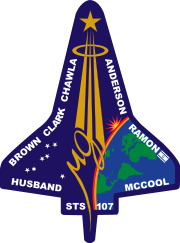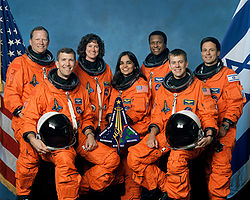Ilan Ramon
| Ilan Ramon אילן רמון |
|
|---|---|
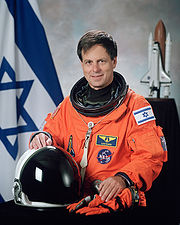 |
|
| ISA astronaut | |
| Nationality | Israel |
| Previous occupation | Fighter pilot |
| Rank | Colonel, Israeli Air Force |
| Time in space | 15d 22h 20m |
| Selection | 1996 NASA Group |
| Missions | STS-107 |
| Mission insignia | |
Ilan Ramon (June 20, 1954 - February 1, 2003; Hebrew: אילן רמון, born Ilan Wolferman[1]) was a fighter pilot in the Israeli Air Force, and later the first Israeli astronaut. Ramon was the space shuttle payload specialist of STS-107, the fatal mission of Columbia, where he and six other crew members were killed in a re-entry accident over Palestine, Texas. Ilan Ramon is the only foreign recipient of the United States Congressional Space Medal of Honor.
Contents |
Personal life
Ramon was born in Ramat Gan, Israel, and grew up in Beersheba. His mother and grandmother were survivors of the Auschwitz concentration camp.[2] The name Ilan means "tree" in Hebrew.[3]
Although considered a secular Jew, Ramon reportedly sought to follow Jewish observances while in orbit. In an interview he said, "I feel I am representing all Jews and all Israelis." He was the first spaceflight participant to request kosher food. He reportedly sought advice from a Chabad Lubavitch rabbi, Zvi Konikov, about how to observe the Jewish Sabbath in space, as the period between sunrises in orbit is approximately 90 minutes. This was referenced by the words "Jerusalem we have a problem" in Rabbi Konikov's speech at the Kennedy Space Center Memorial for Columbia on February 7, 2003.[4]
Aboard STS-107, Ramon carried a pencil sketch, "Moon Landscape", drawn by 16-year-old Petr Ginz, who died in Auschwitz. Ramon also took with him a microfiche copy of the Torah (from the Holocaust) given to him by Israeli president Moshe Katsav. Ramon asked the 1939 Club, a Holocaust survivor organization in Los Angeles, for a symbol of the Holocaust to take into outer space with him. A barbed wire mezuzah by the San Francisco artist Aimee Golant was selected. Ramon also took with him a dollar of the Lubavitcher Rebbe, Rabbi Menachem M. Schneerson.[5] Ramon and the rest of the Columbia crew died over East Texas in the Southern United States during entry into Earth's atmosphere, 16 minutes prior to scheduled landing. [6]
"Miracle" diary
37 pages from the diary he was keeping while in orbit survived the crash and were returned to his widow, Rona, who has shared an excerpt with the Israeli public in a display at Jerusalem's Israel Museum.[7] Rona Ramon brought it to Israel Museum forensic experts. Only 2 pages were displayed, 1 containing Ramon's notes, and the other is a copy of the Kiddush prayer.[8] Curator Yigal Zalmona[9] said the diary was partially restored in 1 year, and needed 4 more, for police scientists to decipher 80% of the text. Zalmona stated: "The diary survived extreme heat in the explosion, extreme atmospheric cold, and then "was attacked by microorganisms and insects. It's almost a miracle that it survived — it's incredible. There is 'no rational explanation' for how it was recovered when most of the shuttle was not, he said."[10] Ramon wrote on the last day of the journal:
| “ | "Today was the first day that I felt that I am truly living in space. I have become a man who lives and works in space." | ” |
Inscribed in black ink and pencil, it covered just the first six days of the 16-day mission. The papers remained white even though, exposed at high speed 37 miles above the Earth, it should have super-heated and burned.[11] Anyway, other fragile items withstood the disaster as well, even in a better shape, like a Caenorhabditis elegans worm culture[12][13][14] –the only survivors of the accident– or a moderately damaged hard disk drive. [15][16] This is a common occurrence in the debris trail of air disasters, where certain parts or objects in the aircraft are blown out of the vehicle and fall freely; when the Columbia disintegrated, she was already an aircraft (if exceptionally high and fast still) rather than a spacecraft.
Education
Ramon graduated from high school in 1972. In 1987, he graduated with a B.Sc. degree in electronics and computer engineering from Tel Aviv University.[6]
Air Force career
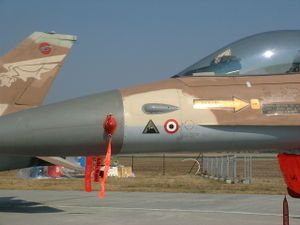
Ilan Ramon was a Colonel (Aluf Mishne) and fighter pilot in the Israeli Air Force, with thousands of hours flying experience. In 1974, he graduated as a fighter pilot from the Israel Air Force (IAF) Flight School. From 1974–1976 he participated in A-4 Basic Training and Operations. 1976–1980 was spent in Mirage III-C training and operations. In 1980, as one of the IAF's establishment team of the first F-16 Squadron in Israel, he attended the F-16 Training Course at Hill Air Force Base, Utah. From 1981–1983, he served as the Deputy Squadron Commander B, F-16 Squadron.[6]
In 1981 he was the youngest pilot taking part in Operation Opera, an Israeli military operation to bomb Iraq's unfinished Osiraq nuclear reactor. The facility was destroyed, killing ten Iraqi soldiers and one French researcher.[17][18]
After attending the Tel Aviv University, he served as Deputy Squadron Commander A, F-4 Phantom Squadron (1988–1990). During 1990, he attended the Squadron Commanders Course. From 1990–1992, he served as Squadron Commander, F-16 Squadron. From 1992–1994, he was Head of the Aircraft Branch in the Operations Requirement Department. In 1994, he was promoted to the rank of Colonel and assigned as Head of the Department of Operational Requirement for Weapon Development and Acquisition. He stayed at this post until 1998. Ramon accumulated over 3,000 flight hours on the A-4, Mirage III-C, and F-4, and over 1,000 flight hours on the F-16.[19]
NASA experience

NASA on-ground trainings
In 1997, Ramon was selected as a Payload Specialist. He was designated to train as prime for a space shuttle mission with a payload that included a multispectral camera for recording desert aerosol (dust). In July 1998, he reported for training at the Johnson Space Center, Houston, Texas, where he trained until 2003. He flew aboard STS-107, logging 15 days, 22 hours and 20 minutes in space.
Space flight
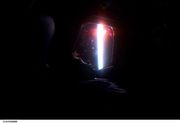
STS-107 Columbia (January 16 - February 1, 2003). The 16-day flight was a dedicated science and research mission. Working 24 hours a day, in two alternating shifts, crew successfully conducted approximately 80 experiments. The STS-107 mission ended abruptly when Space Shuttle Columbia was destroyed and its crew perished during re-entry, 16 minutes before scheduled landing.
Family
Ramon was survived by his wife Rona and their four children, who were in Texas at the time of the accident. His eldest son, Captain Assaf Ramon, perished on September 13, 2009, aged 21, during a routine training flight while piloting his F-16A, 3 months after graduating from the IAF flight school with the Sword of Honor as the top cadet in his graduating class.[20]
Awards and honors
- Military decorations:
- Yom Kippur War (1973)
- Operation Peace of the Galilee (1982)
- F-16 1,000 Flight Hours (1992).
- Posthumously awarded:
- NASA Space Flight Medal
- NASA Distinguished Public Service Medal
- Congressional Space Medal of Honor (Ramon is the only non-U.S. citizen recipient to date) [21]
- Chief Of Staff Medal of Appreciation
Legacies (in Israel unless specified otherwise)

Ramon AZA #195 (Honoring both Ilan Ramon, and Asaf Ramon) in United states CA; International airport at Timna to be named in honor of Ilan and Assaf Ramon[22]
- Asteroid 51828 Ilanramon
- Ramon Hill, in Columbia Hills, Mars
- Ramon Hall, in the Columbia Village apartments, Florida Institute of Technology[23]
- Ilan Ramon Youth Physics Center, Ben-Gurion University of the Negev, Beersheba
- Ramon Control Tower, Ben-Gurion Airport
- Ilan Ramon Elementary School, Netanya
- Ramon Elementary School, Modi'in
- Ramon High school, Hod Hasharon
- Ilan Ramon Junior High, Kokhav Ya'ir[24]
- Ilan Ramon Emergency Center, Kaplan Hospital, Rehovot
- Ilan Ramon Boulevard[25][26]Vaughan, Ontario
- Ramon Park, Givat Shmuel
- Ilan Ramon Park, space-themed playground, Beersheba
- Ilan Ramon AZA #380, Boulder, Colorado
- Ilan Ramon BBYO #5378, Oviedo, Florida
- Ilan Ramon Crescent, Cote St. Luc, Montreal, Quebec (Canada)
See also
- Space Shuttle Columbia disaster
- Columbia: The Tragic Loss, a documentary that focuses on Ilan Ramon
References
- ↑ http://books.google.com/books?id=a8G9I_a2s9oC&lpg=PP1&ots=DiTWd57uWU&dq=ilan%20ramon&pg=PA10#v=onepage&q&f=false
- ↑ Haaretz Web site
- ↑ Behind the Name website
- ↑ Chabad.org official website
- ↑ Israeli astronaut busy up in space
- ↑ 6.0 6.1 6.2 Payload Specialist Astronaut Bio: Ilan Ramon, National Aeronautics and Space Administration (NASA) Retrieved 2009-12-05
- ↑ Ohm, Shawna (2008-10-03). "Astronaut's diary goes on display in Jerusalem". Associate Press. http://news.yahoo.com/s/ap/20081003/ap_on_re_mi_ea/ml_israel_astronaut_s_diary. Retrieved 2008-10-04.
- ↑ Ibid.
- ↑ Photos of "miracle" diary here
- ↑ Astronaut's diary goes on display in Jerusalem
- ↑ The Guardian report of the diary that survived shuttle blast
- ↑ Szewczyk, Nathaniel, et al. (2005). "Caenorhabditis elegans Survives Atmospheric Breakup of STS-107, Space Shuttle Columbia". Mary Ann Liebert, Astrobiology. http://www.liebertpub.com/prdetails.aspx?pr_id=428. Retrieved November 2, 2006.
- ↑ "Worms survived Columbia disaster". BBC News. 2003-05-01. http://news.bbc.co.uk/2/hi/science/nature/2992123.stm. Retrieved 2005-12-16.
- ↑ Worms Survive Shuttle Disaster Fall 2003
- ↑ Fonseca, Brian (2008-05-07). "Shuttle Columbia's hard drive data recovered from crash site". Computerworld.com. http://www.computerworld.com/action/article.do?command=viewArticleBasic&articleId=9083718. Retrieved 2009-09-01.
- ↑ "The Physics of Whipped Cream". Science.nasa.gov. http://science.nasa.gov/headlines/y2008/25apr_cvx2.htm. Retrieved 2009-09-01.
- ↑ Astronaut Ilan Ramon's son dies in IAF crash, Haaretz.com, September 13, 2009
- ↑ "Factfile: How Osirak was bombed". BBC News. June 5, 2006. http://news.bbc.co.uk/1/hi/world/middle_east/5020778.stm. Retrieved May 5, 2010.
- ↑ Ibid.
- ↑ Death of Ilan Ramon's son, Asaf Ramon (hebrew)
- ↑ "Congressional Space Medal of Honor". NASA. April 28, 2006. http://history.nasa.gov/spacemedal.htm. Retrieved 2009-12-05.
- ↑ "New Timna airport to be named after Ilan and Assaf Ramon"
- ↑ "Florida Tech dedicates dorms to Columbia 7"
- ↑ Ilan Ramon Junior High, Kochav-Yair
- ↑ UJA Foundation: Lag B'omer festival
- ↑ UJA Foundation
External links
- Official biography at NASA
- Photo of Ilan Ramon with Chabad Rabbi Zvi Konikov
- Ilan Ramon STS-107 Crew Memorial
- A collection of articles about Ilan Ramon
- Portrait painting of the first Israeli astronaut, Col. Ilan Ramon
- Ilan Ramon Memorial pages in the Israel Science and Technology Directory
- Spacefacts biography of Ilan Ramon
- Excerpts from Ilan Ramon's diary
- Ilan Ramon at Find a Grave
- Ilan Ramon - Obituary and public tribute
|
||||||||
|
|||||||||||||||
|
||||||||||||||||||||||||||||||||
